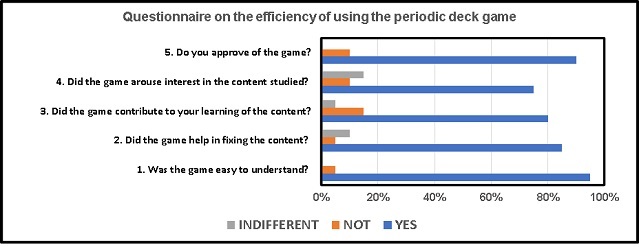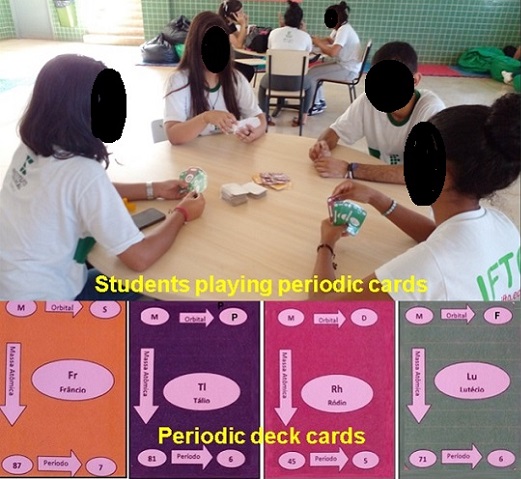Autores
Araújo, T.L. (IFTO CAMPUS PARAÍSO DO TOCANTINS) ; Viroli, S.L.M. (IFTO CAMPUS PARAÍSO DO TOCANTINS)
Resumo
The use of games in teaching promotes fun, relaxed learning and an alternative
to assess the learning of the content studied. In order to stimulate the
teaching of Chemistry, this study produced and used a didactic card game called
periodic deck as a teaching-learning instrument to approach the content on the
periodic table. The modified methodology proposed by Dionizio was used. The game
was carried out with the participation of 40 students from the 1st year of High
School Integrated to the Environmental Technician Course After the application
of the game, a questionnaire with 5 closed questions was applied. It is
concluded that the game achieved the objective of a tool to teach the Periodic
Table and the chemical elements in a playful way.
Palavras chaves
Meaningful Learning; Chemical elements; Chemistry teaching
Introdução
The traditional teaching of the Chemistry discipline, carried out in the
memorization of formulas, absence of practical classes, decontextualization and
extensive monotonous content during learning generates discouragement, inhibits
the curiosity and interest of the student in the discipline, establishing a
mismatch between the content taught in the classroom class with their daily
lives (CASTRO et al., 2015). Chemistry teaching needs the application of
motivating classes that involve students with investigative activities,
stimulating the understanding of natural and everyday phenomena from the
analysis and association with scientific knowledge (CARVALHO, 2013; SASSERON
2013). Many didactic methodologies seek to promote the learning of the contents
of the subjects taught in high school. The use of media, playful and
experimental approaches used in the classroom help teachers in pedagogical
practice and arouse the student's attention, stimulating interest in the
contents taught (CASTRO et al., 2015; OLIVEIRA et al., 2015). Among these
methodologies, didactic games stand out as a possibility for teaching the
contents of the Chemistry subject, as it is a great pedagogical strategy, with
engaging language establishing the learning of various skills (LEÃO et al,
2019). The use of games in teaching promotes fun, relaxed learning and an
alternative to assess the learning of the content studied (ZANON, GUERREIRO and
OLIVEIRA, 2008). In order to stimulate the teaching of Chemistry, this study
produced and used a didactic card game as a teaching-learning instrument to
approach the content on the periodic table with students of the 1st Year of High
School of the Technical Course in the Environment of federal Institute of
Education of Tocantins.
Material e métodos
The modified methodology proposed by Dionizio (2018) was used, where the three
(3) students of the 3rd period of the Degree in Chemistry of the Federal
Institute of Tocantins campus Paraíso do Tocantins made a card game composed of
136 cards, where 118 symbolized the chemical elements represented in the
periodic table (92 natural and 26 artificial) and 18 special (6 blocking cards,
6 inversion cards and 6 wild cards). The materials used to make the game were:
bond paper, printer, computer, adhesive plastic, scissors and rectangular pieces
(10x7cm) of blue, yellow, red and green cardboard. The deck was divided into
yellow, blue, red, and green colors representing the s, p, d, and f sublevels,
respectively. The chemical element card contained information with the name,
symbol, atomic number, and sublevel of the corresponding chemical element. As
the rules of this game were similar to the rules of the Uno game, developed by
Merle Robbins and commercialized in Brazil by the company Copag, the
understanding and application of this methodological proposal were carried out
with ease. The game was played with the participation of 40 students from the
1st year of High School Integrated to the Environmental Technician Course, in
June 2022, who study at the same institution and campus as the students. After
the application of the game, a questionnaire with 5 closed questions was
applied: 1. Was the game easy to understand? 2. Did the game help in fixing the
content? 3. Did the games contribute to your learning of the content? 4. Did the
game arouse interest in the content studied? 5. Do you approve of the game? so
that the positive and negative aspects of this teaching strategy could be
evaluated.
Resultado e discussão
Graph 1 informs that the results obtained were satisfactory. The students of the
1st Year of the Integrated Medium of the Technical Course in Environment
declared that 95% considered the game to be easy, as the rules of this game were
similar to the rules of the Uno game, which they were already familiar with.
When asked about the game helped in fixing the contents, 85% said yes, 5% said
no and 10% were indifferent. Regarding the game, they contributed to the
learning of the content, 80% confirmed the contribution, 15% denied it and 5%
were indifferent. When asked about arousing interest in the content studied, 75%
said yes, 10% denied it and 15% were indifferent. Regarding the approval of the
periodic deck game, 95% approved the game and 5% did not. The non-approval of
the game is due to the fact that the 2 students did not understand the rules of
the game. It was observed participation, relaxation and involvement of students
during the game. The game contributes to a more meaningful learning about the
Periodic Table content, provoking students' curiosity, interaction and
socialization of information among students, motivating them and thus ensuring
success in the assimilation of the content studied in the classroom. According
to Santos (2008), this is likely due to the fact that lately research focused on
the use of games is proving the increase in significance in learning when this
playful didactic tool is performed in the educational context of students.
According to Soares (2008), motivation precedes interest. If students are
motivated to participate in an activity, then interest arises. If there is no
motivation, there is no interest. Braga et al (2014), applying a periodic deck,
obtained a good academic performance in a fun way.


Conclusões
The periodic deck applied to fix and evaluate students' learning about the
Periodic Table and the chemical elements, transmitting the content approached in
a playful way and arousing interest in learning the content involved in the
discipline. It is concluded that the game has contributed satisfactorily to a
more significant learning about the content of the Periodic Table with acceptance
and learning considered, thus achieving the objective of using this game as a
tool for teaching the Periodic Table and chemical elements in a playful way.
Agradecimentos
To God, to the IFTO campus Paraíso do Tocatins
Referências
BRAGA, D.O.; PAZ, W.H.P.; LIMA, F.C.A. Baralho periódico: um jogo lúdico para o ensino da tabela periódica. In: CONGRESSO BRASILEIRO DE QUIMICA, 54., 2014, Matal. Anais Eletrônicos [...]. Natal, 2014. Disponível em: http://www.abq.org.br/cbq/2014/trabalhos/6/4861-18840.html. Acesso em: 21 maio. 2022
CARVALHO, A. M. P. de. O Ensino de Ciências e a proposição de sequências de Ensino Investigativas. In: CARVALHO A. M. P. de. (Org.). Ensino de Ciências por investigação: condições para implementação em sala de aula. 1ed. São Paulo: Cengage Learning, v. 1, pp. 1 - 20, 2013
CASTRO, D.L.; DIONIZIO, T.P.; SILVA, I. G. Na trilha dos elementos químicos: o ensino de Química através de uma atividade lúdica. Revista Brasileira de Ensino de Química, v. 10, n. 1, p. 46-58, 2015.
LEÃO, M.F.; FANTINELL JÚNIOR, M.; COSTA, A.N.S.; ALVES, A.C.T. Jogos didáticos no ensino de ciências: maneira diferenciada de ensinar e aprender sobre poluição. In: CONGRESSO BRASILEIRO DE QUIMICA, 59., 2019, João Pessoa. Anais Eletrônicos [...]. João Pessoa, 2019. Disponível em: http://www.abq.org.br /cbq/2019/trabalhos/5/956-27759.html. Acesso em: 21 maio. 2022
OLIVEIRA, J. S.; SOARES, M. H. F. B.; VAZ, W. F. Banco Químico: um jogo de tabuleiro, cartas, dados, compras e vendas para o ensino do conceito de soluções. Química Nova na Escola, v. 37, n. 4, p. 285-293, 2015.
SANTOS, S.M.P. (Org.) A ludicidade como ciência. 2. ed. Rio de Janeiro: Vozes, 2008.
SASSERON, L. H. Interações discursivas e investigação em sala de aula: o papel do professor. In: Anna Maria Pessoa de Carvalho. (Org.). Ensino de Ciências por investigação: condições para implementação em sala de aula. 1ed.São Paulo: Cengage Learning, v. 1, pp. 41 - 62, 2013
SOARES, M. F. F. Jogos em Ensino de Química: Teoria, Métodos e Aplicações. 1. Ed. Guarapari-ES: Editora Ex Libris, p. 170, 2008.
ZANON, D. A. V.; GUERREIRO, M. A. S.; OLIVEIRA, R. C. Jogo didático Ludo Químico para o ensino de nomenclatura dos compostos orgânicos: projeto, produção, aplicação e avaliação. Ciências & Cognição, v. 13, n. 1, p. 72-81, 2008.
















